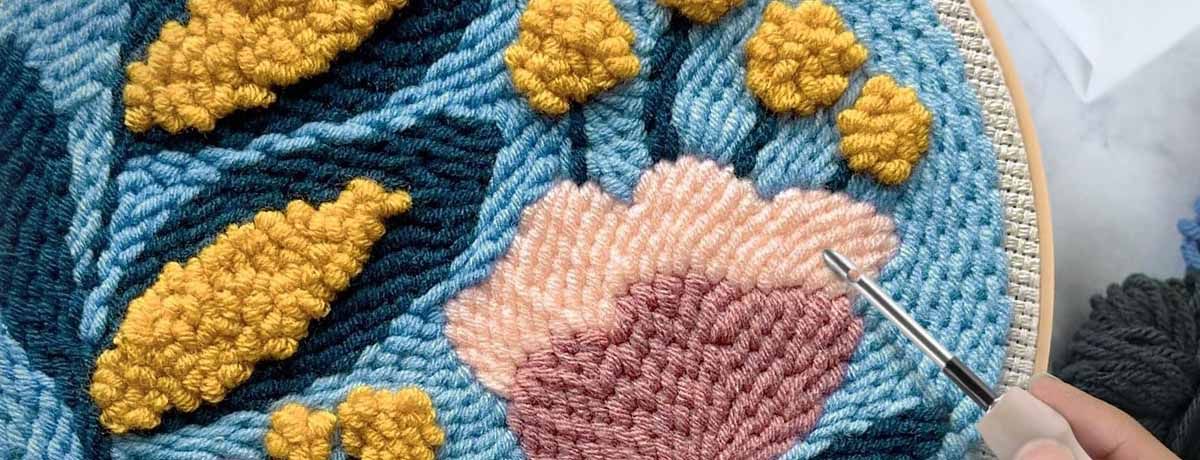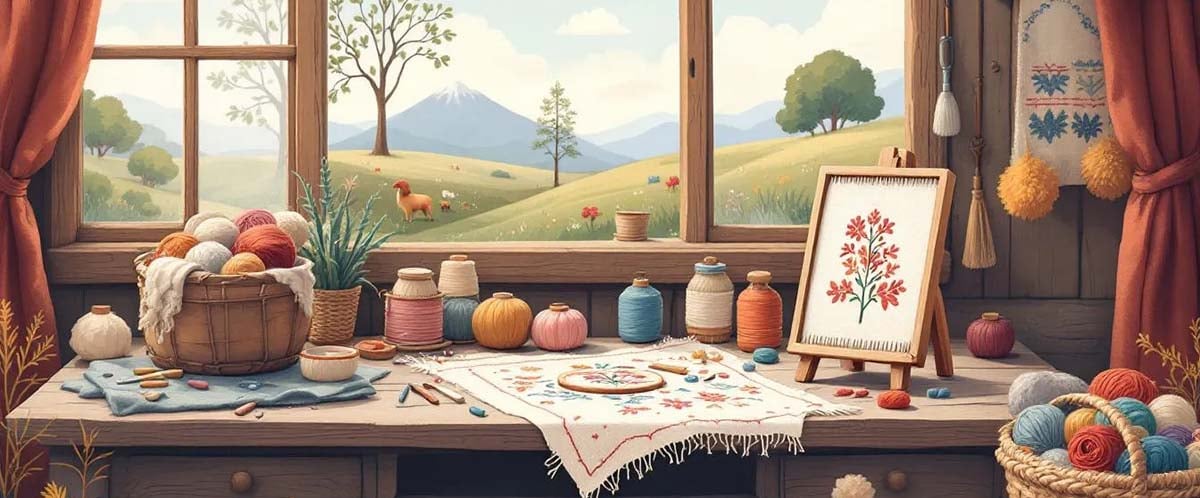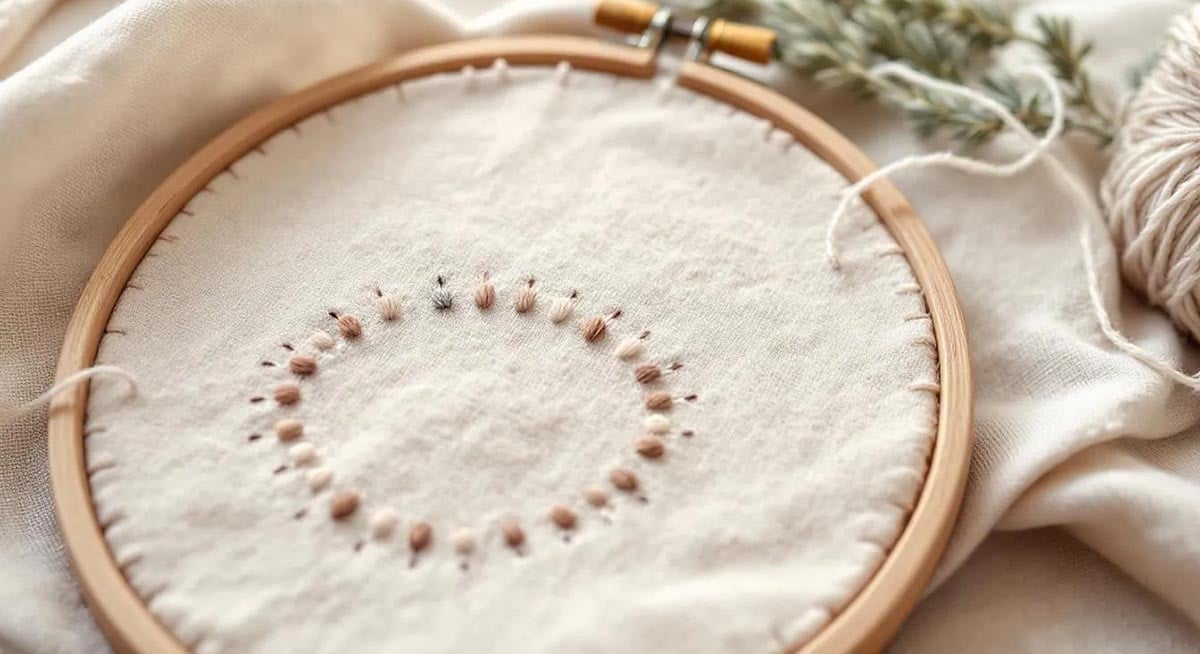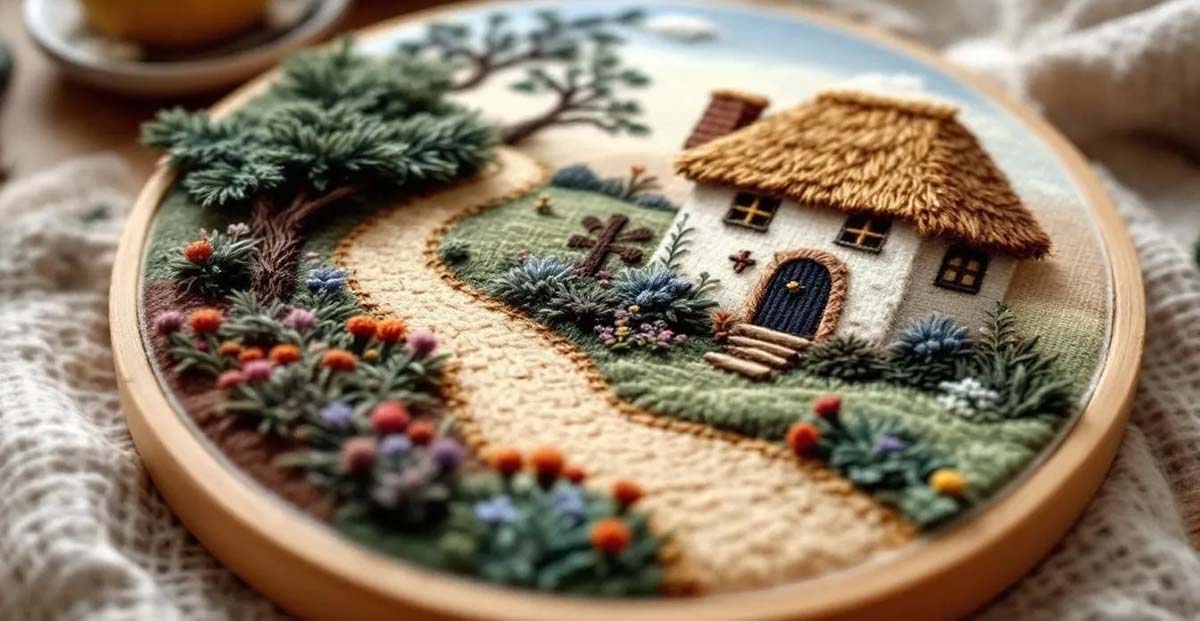Master Punch Needle Sewing: A Beginner's Guide to Fun and Easy Crafts

Punch needle sewing is a craft where you use a special needle to make loops in fabric, creating textured designs. This guide will help you get started with the tools you’ll need, basic techniques, and project ideas.
Key Takeaways
-
Punch needle sewing is a historical craft that blends traditional techniques with modern creativity, allowing for personalized artistic expression.
-
Selecting appropriate tools, yarn, and fabric is crucial for successful punch needle projects; wool yarn and monk’s cloth are highly recommended for best results.
-
Creating a comfortable workspace and mastering basic techniques are essential for beginners; troubleshooting common issues ensures well-formed loops and consistent results.
Understanding Punch Needle Sewing

Punch needle sewing boasts a history that stretches back hundreds, if not thousands, of years. Originating in medieval garments, this craft has evolved significantly over the centuries. In the late 1800s, artisans began creating intricate designs in textiles and rugs, transforming the craft into a recognized art form. This historical depth adds a layer of richness to the craft, making each punch needle project a continuation of a long-standing tradition. Needle punch, as a fiber art technique, uses a special punch needle tool to create loops and stitches on fabric, and has become increasingly popular for its versatility and accessibility.
There are three main traditional styles of punch needle that continue to influence the modern practice:
-
Rug hooking: characterized by bold, textured loops.
-
Russian miniature embroidery: known for delicate, detailed stitches.
-
Japanese Bunka embroidery: also features delicate, detailed stitches.
These traditional methods provide a foundation upon which contemporary punch needle works are built, blending old-world Crafts with new-world creativity.
In recent years, punch needle art has experienced a renaissance, largely thanks to social media platforms where artists share their vibrant, innovative designs. Modern artisans are pushing the boundaries, creating bold punch needle patterns that diverge from traditional folk art motifs. This blend of historical techniques and contemporary flair makes the punch needle world an exciting space for both beginners and seasoned crafters.
As we explore the punch needle world, you’ll see how this craft allows for endless creativity and personalization. Whether you’re inspired by traditional designs or modern aesthetics, punch needlesewing offers a flexible and rewarding way to express your artistic vision through punch needle design.
Getting Started with Punch Needle Kits
If you’re new to punch needle embroidery, starting with punch needle kits is a fantastic way to jump right in. These kits are thoughtfully curated to include everything you need for your first punch needle project—typically a punch needle tool, foundation fabric, yarn or embroidery floss, and a punch needle pattern to follow. By providing all the essential tools and materials in one package, punch needle kits take the guesswork out of gathering supplies, making it easy for beginners to focus on learning the craft.
When choosing a punch needle kit, think about the type of project you want to create. Some kits are designed for punch needle rug hooking and come with sturdy wool yarn and durable fabric, perfect for making rugs or textured wall hangings. Others might include finer embroidery floss for more delicate needle embroidery projects. Be sure to check that the kit matches your desired outcome—whether it’s a cozy pillow, a decorative wall hanging, or a small rug.
Reading reviews and following the included instructions will help you get the best results from your kit. Many kits also offer step-by-step guides or video tutorials, making it even easier to master the basics of punch needle embroidery. With the right kit, you’ll be well on your way to creating beautiful, textured punch needle works in no time.
Essential Punch Needle Tools and Supplies
Every great punch needle project begins with the right tools and supplies. The punch needle tool is central to this craft. It features a long, hollow design with a beveled point and a large eye. This essential tool, along with the right fabric and yarn, forms the trinity of punch needle embroidery and needles. Ensuring that these elements work well together is key to a successful project.
Beginners might find it helpful to start with a pre-made punch needle kits. These kits simplify the process by providing all necessary materials and clear instructions, making it easier to dive into your first punch needle project without the guesswork.
Here’s how to select the right tool, yarn, and fabric for your punch needle endeavors.
Selecting the Right Punch Needle Tool
Selecting the appropriate punch needle tool is fundamental to your punch needle journey. Consider the following when choosing your tool:
-
Tools come in different lengths and thicknesses.
-
Some feature adjustable depth gauges to customize the length of your loops.
-
Beginners should choose a needle that matches the thickness of their chosen yarn.
-
Comfort and control are paramount; opt for a tool that feels good in your hand and provides stability during use.
The quality of your needle punch tool can greatly affect ease of use, especially for beginners. Common issues like needle slipping or poor build quality can make needle punch projects more difficult and less enjoyable.
To use your punch needle tool effectively:
-
Hold the tool like a pencil with the open slot facing the direction you’re working for optimal control.
-
This grip offers the best control and precision, allowing you to create beautiful, even stitches.
-
Avoid tools that don’t tighten or are only designed for traditional embroidery, as they may not provide the desired results in punch needle projects.
Choosing Yarn for Punch Needle Projects
Your choice of yarn greatly affects the final look and durability of your punch needle project. Wool rug yarn is highly recommended for items like pillows and rugs due to its durability and texture. Wool yarn, in general, is preferable over acrylic options, as it tends to hold the loops better and provides a more polished finish.
Opting for natural fibers like wool enhances the overall quality of your punch needle works:
-
A well-twisted wool yarn looks great.
-
It ensures that the loops effectively grip the fabric, preventing unravelling.
-
Synthetic yarns might be tempting but often lack the durability and aesthetic appeal of natural fibers.
Best Fabrics for Punch Needle Embroidery
Choosing the right fabric is equally important as selecting your yarn and needle. Monk’s cloth is the most recommended fabric for punch needle embroidery due to its smooth texture, pliability, and sturdiness. This fabric effectively holds the yarn, ensuring that your loops remain in place and your design stays intact.
In addition to monk’s cloth, other suitable options include primitive linen, burlap, and rug warp. These fabrics provide a solid foundation for various punch needle projects, from decorative pillows to stuffed toys. Finding the correct type of monk’s cloth can sometimes be challenging, but online retailers specializing in punch needle supplies often carry the best options.
How to Set Up Your Punch Needle Workspace
A comfortable and efficient workspace is crucial for a pleasant punch needle experience. Good lighting is crucial to avoid straining your eyes during long crafting sessions. Position your workspace near a natural light source or use a bright lamp to ensure you can clearly see your work.
Organization is another key aspect. Keeping your tools and materials within reach can enhance efficiency and allow you to focus on your project, including details about managing depending on your settings without unnecessary interruptions, age appropriate if relevant. We also use cookies and data to improve your video experience, watch and the things.
Comfortable seating that supports your posture is also important, as it helps reduce fatigue and keeps you comfortable while you work on your punch needle designs.
Basic Techniques in Punch Needle Sewing
Learning the basic techniques is the first step toward creating beautiful punch needle projects. Start by threading your punch needle tool correctly, as improper threading can hinder yarn flow and affect loop formation. Once threaded, make a series of stitches from the back side of the fabric, creating loops that are held in place by the fabric’s tension.
Proper tension in both fabric and yarn is vital. Too loose, and your loops may unravel; too tight, and punching becomes difficult. Ensure your fabric is stretched tightly in the embroidery frame to achieve consistent stitches. These foundational techniques will set you on the path to punch needle success.
For beginners, watching videos that demonstrate step-by-step punch needle techniques can be especially helpful for understanding and mastering the basics.
Starting Your First Punch Needle Project

Starting your first punch needle project can be both thrilling and daunting. Start by stretching your woven foundation fabric on a gripper strip frame or a no-slip embroidery hoop. This setup keeps the fabric taut, making it easier to create uniform loops.
For your first project, consider the following tips:
-
Use simple geometric shapes to practice your technique without overwhelming complexity.
-
Start with small projects like a mug rug, which are ideal for beginners and allow you to hone your skills before tackling larger pieces.
-
Utilize online tutorials for valuable visual guidance to improve your technique.
Troubleshooting Common Punch Needle Issues
Even with careful preparation, you might encounter some common issues in punch needle sewing. Ensure the punch needle is fully inserted through the fabric during each stitch to create even loops. A common beginner mistake is not stretching the fabric taut enough, leading to uneven loops and instability in the design.
To achieve more uniform loops and prevent unraveling:
-
Punch the needle down to the handle on every stitch.
-
Prevent loops from unraveling by not pulling the needle too far from the fabric and maintaining enough slack in the yarn.
-
Use monk’s cloth, which has a loose weave, to help create loops effectively.
Exploring Advanced Punch Needle Designs
Once comfortable with the basics, you can explore more advanced punch needle designs. Multi-color patterns can significantly enhance the visual appeal of your finished piece. Experimenting with different yarn weights and materials can add unique characteristics to your projects, making them truly one-of-a-kind.
Techniques like shading and sculpting can elevate your punch needle art to new levels. Don’t be afraid to push the boundaries and explore new materials and methods. This creative freedom makes punch needle sewing both rewarding and engaging.
Creative Punch Needle Project Ideas
Punch needle sewing’s versatility allows for a wide array of projects beyond traditional rugs. Unique wall hangings, decorative cushions, and stunning table runners are just a few ideas to get your creative juices flowing. This craft encourages experimentation with various designs and color combinations, allowing you to personalize your home decor or make thoughtful, handmade gifts through punch needle rug hooking.
Punch needle techniques are great for personalized gifts, such as custom cushions and decorative signs. The possibilities are endless, and the only limit is your imagination. Dive into the punch needle world and let your creativity soar.
Finding Inspiration and Resources
One of the joys of punch needle embroidery is the endless inspiration available at your fingertips. Whether you’re searching for fresh punch needle patterns, new techniques, or creative project ideas, the internet is a treasure trove of resources. Social media platforms and YouTube are especially valuable for discovering tutorials, watching step-by-step demonstrations, and seeing how other crafters approach their punch needle projects.
Many talented creators share their punch needle embroidery journeys online, offering tips on using different types of yarn—like embroidery floss for fine details or chunky wool for bold textures—and experimenting with various punch needle tools. You’ll find everything from beginner-friendly guides to advanced needle embroidery techniques, all designed to help you grow your skills.
Don’t forget to visit your local craft store, where you can browse new tools, yarns, and fabrics in person. Joining a crafting group or workshop can also spark new ideas and connect you with fellow enthusiasts. The more you explore, the more you’ll discover what inspires you—so don’t hesitate to try new punch needle patterns, play with color combinations, and develop your own unique punch needle design style.
Finishing and Preserving Your Punch Needle Art

Finishing your punch needle project is just as important as the crafting process itself. Framing your punch needle artworks enhances their visual appeal and protects them from damage. Backing the finished project with fabric or felt provides stability and a polished look.
To maintain your punch needle art:
-
Gently clean it with a soft brush or lint roller.
-
After completing the design, remove it from the frame.
-
Trim any remaining yarn ends.
-
Straighten stray loops.
These steps will ensure your punch needle projects remain beautiful and intact for years to come.
Punch Needle Community and Resources
The punch needle world is full of passionate crafters eager to share their knowledge and creativity. Online forums, social media groups, and dedicated websites are excellent places to connect with others who love punch needle embroidery, whether you’re interested in traditional embroidery, rug hooking, or modern punch needle projects. These communities are welcoming to beginners and experienced makers alike, offering advice on everything from fixing uneven loops to choosing the best punch needle tool for your needs.
Many groups host challenges, share free punch needle patterns, and provide feedback on your finished projects. You’ll also find artists who sell their handmade punch needle works or accept custom orders, giving you a chance to see the craft in action and even commission a personalized piece.
For those looking to deepen their understanding, there are books, online classes, and workshops covering the history, techniques, and creative possibilities of punch needle embroidery. No matter your skill level or area of interest, you’ll find support, inspiration, and a sense of belonging in the vibrant punch needle community. Dive in, share your progress, and enjoy being part of a creative movement that celebrates both tradition and innovation.
Summary
Throughout this guide, we’ve explored the fascinating world of punch needle sewing, from its rich history to the essential tools and techniques needed to create stunning projects. Whether you’re a beginner or looking to advance your skills, punch needle embroidery offers endless possibilities for creativity and self-expression.
As you embark on your punch needle journey, remember that practice and experimentation are key. Enjoy the process, embrace your creativity, and don’t be afraid to make mistakes. Happy punching!
Contact MH
MH offer punch needle, feel free to reach out to us for more details or inquiries. We're here to help!


